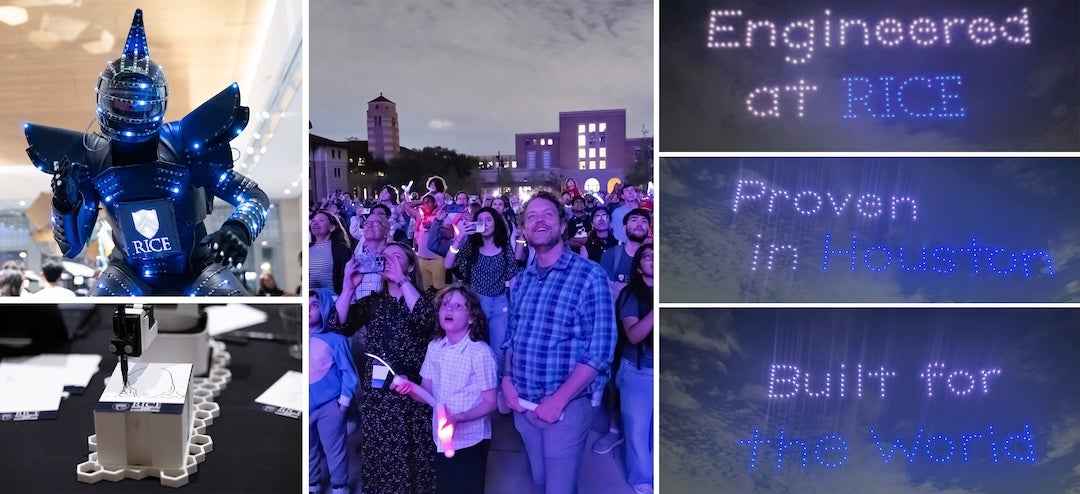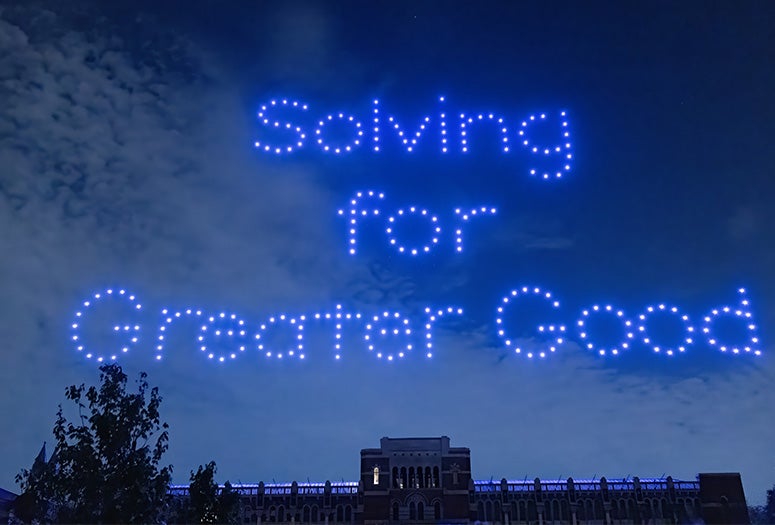Rice University’s George R. Brown School of Engineering and Computing celebrated half a century since its official inception with two days of events that gathered together nearly 400 people, including staff, faculty, students, alumni and friends of the school. Held March 28-29, the celebration included panel discussions as well as lab tours, alumni gatherings and student showcases.
“This moment gives us an opportunity to reflect on where we started, how far we have come and the extraordinary impact this school has made over the past five decades,” Rice President Reginald DesRoches said during opening remarks. “Engineering is more than a discipline; it’s a mindset, a way of thinking that solves complex problems and improves lives. And that is exactly what Rice engineers and computer scientists have been doing for 50 years.”
At the start of the celebration, Amy Dittmar, the Howard R. Hughes Provost and executive vice president for academic affairs, praised the school’s impact at the local, national and global level, noting it is a “shining example of how higher education builds America and research saves lives.”
Luay Nakhleh, the William and Stephanie Sick Dean of Engineering and Computing, welcomed guests and provided an overview of the school’s history and achievements. Nakhleh pointed out that while the school itself formally dates back to 1975 ⎯ when the growing number of departments at the university reorganized into two distinct schools ⎯ engineering at Rice stretches back over a century to the university’s opening in 1912.
The school’s mission of solving for greater good was a core message in Nakhleh’s opening remarks. Part of the vision and ethos that inspires this commitment is embodied in the speech that John F. Kennedy delivered at Rice in 1962, which notes that the “new knowledge to be gained and new rights to be won … must be won and used for the progress of all people.”

As he wrapped up his welcome address, Nakhleh shifted focus from the past and the history of the school to its future.
“We want to continue to be a school that focuses on solving for greater good,” Nakhleh said. “We want to work on problems of societal impact that change the lives of people for the better. … Even though the research is engineered at Rice and even though it is proven in Houston, we want these solutions to be built for the world.”
The morning concluded with the bestowal of a proclamation from the Office of the Mayor of Houston, John Whitmire, recognizing March 28, 2025, as George R. Brown School of Engineering and Computing Day.
The first day of celebrations continued with three faculty-led panels featuring distinguished Rice engineering alumni tackling major topics at the heart of the school’s mission and history: computing, energy and sustainability and entrepreneurship.
In the computing panel ⎯ moderated by Lydia Kavraki, director of the Ken Kennedy Institute and the Kenneth and Audrey Kennedy Professor of Computing ⎯ distinguished alumni in the technology industry and academia explored the societal shifts driven by artificial intelligence (AI), the ethical questions surrounding data use and the urgency of improving data literacy for all.

The discussion helped emphasize the through-line connecting Rice’s early computing milestones ⎯ such as the 1961 operational launch of R1, then the largest and fastest computer constructed on a university campus, and the pioneering work in digital signal processing ⎯ to the present day. Last year, the school formally included “computing” in its name to underscore the centrality of this domain to its identity and trajectory.
The energy and sustainability panel highlighted Houston’s role as energy capital of the world and its emergence as a “Silicon Valley” of energy. Panelists discussed advancements in next-generation energy technologies, critical mineral supply chains, hydrogen, carbon capture and more. Aditya Mohite, the William M. Rice Trustee Professor of Chemical and Biomolecular Engineering and faculty director of the Rice Engineering Initiative for Energy Transition and Sustainability (REINVENTS), helped steer the discussion.
The forward-looking conversation focused on how engineering is propelling a shift toward cleaner, sustainable energy solutions. It also spotlighted Rice’s leadership in this arena ⎯ evidenced by collaborative efforts like REINVENTS ⎯ which leverages academic and industry partnerships to accelerate breakthroughs in energy production, storage and efficiency. These efforts tie into Rice’s decades-long contributions in energy research and its partnerships within the Houston energy corridor.
In the entrepreneurship panel, leaders in innovation ⎯ all Rice engineering alumni turned founders ⎯ shared their insights on transforming engineering ideas into successful ventures. The discussion underscored Rice’s culture of entrepreneurship. Paul Cherukuri, vice president for innovation and chief innovation officer, served as moderator.

The day’s formal activities culminated in a lively alumni and student networking event and a rooftop reception for distinguished guests held in the Ralph S. O’Connor Building for Engineering and Science, a 250,000-square-foot facility inaugurated in 2023. In the evening, the O’Connor lobby, the nearly 8,000-square-foot pavilion installed in the historic engineering quad and the surrounding lawn transformed into a party scene with music, lawn games and LED-bedecked stilt-walking robots.
The evening concluded with a spectacular drone show over the main Academic Quadrangle. As they rose in formation over Lovett Hall, the drones cycled through a series of images evocative of the school’s breakthrough contributions to research and innovation in medicine, energy and computing such as the development of the first artificial heart and record perovskite solar panel efficiency.
Moving from the outline of iconic campus buildings to the Houston skyline and Texas Medical Center and finally to an image of the planet spinning around its axis, the show left a distinct sense of innovation and discovery for the common good as the defining trajectory of the school connecting its past to its future: “Engineered at Rice, proven in Houston, built for the world.”
On the second day, guests reconvened for a morning keynote address delivered by Gary S. May, chancellor of University of California, Davis. Titled “The Future of Engineering in Academia and the World,” the keynote highlighted inclusive excellence as a driver of continuing improvement in engineering design and outcomes. Next, a fireside chat between May and DesRoches explored a series of wide-ranging topics from workforce development to interdisciplinarity, entrepreneurship and more.

Guests were invited to tour a number of labs across campus from the Biosciences Research Collaborative to the Oshman Engineering Design Kitchen. Students and faculty welcomed guests into maker spaces and research facilities, demonstrating the ethos of hands-on, impact-driven education.
The celebration concluded with a forward-looking lunch panel moderated by Lisa Biswal, senior associate dean of engineering and computing and the William M. McCardell Professor in Chemical Engineering. Richard Baraniuk, the C. Sidney Burrus Professor of Electrical and Computer Engineering, spoke on the initiatives around open education resources and the role of responsible AI for education. Qilin Li, professor of civil and environmental engineering, addressed global water challenges and the need to reimagine water treatment and distribution infrastructure, technologies and sourcing. Rebecca Richards-Kortum, the Malcolm Gillis University Professor and co-director of the Rice360 Institute for Global Health Technologies, delivered an impassioned talk on trailblazing efforts to end preventable newborn deaths.
The two-day celebration honored a legacy of innovation while reaffirming the school’s mission as a force for public good.

